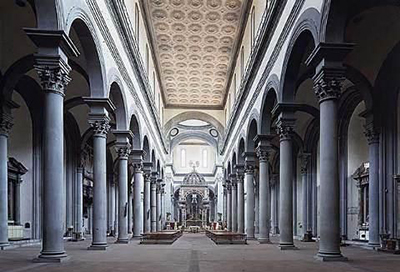This biography deconstructs the career of Filippo Brunelleschi into its various stages and outlines his key architectural works in detail, whilst also examining his relationships and influences
Filippo Brunelleschi was unquestionably one of the most significant members of the Renaissance, specialising in the medium of architecture. There were important elements to his career in other areas of the Renaissance, including engineering, but it is his design of buildings, inside and out, that remains most strongly linked to his artistic reputation. Top if the list is his work on the Cathedral of Santa Maria del Fiore in Florence, be it his Dome, Lantern or Exedrae.
Florence in Tuscany was the most important city of all in the Renaissance and Filippo Brunelleschi was born here in 1377. At the time it was a wealthy republic that boasted several well connected individuals that were looking to commission the finest art in all of the papal states. Brunelleschi was at the forefront of the early stages of the change in styles of architecture during this movement, making his contribution particularly important.
Engineering, art and architecture can go hand-in-hand in many cases and Brunelleschi's engineering skills would create the machines necessary to make his architectural plans reality. The Renaissance was an art movement remembered for versatile artists, but this was still particularly unusual.
The Early Development of Filippo Brunelleschi
It has proven hard to document much from the late 14th century of any artist, and most of what we understand about this architect is from his middle ages and onwards. He came from a well established family and was afforded the opportunities that others with equal abilities may not have received.
Brunelleschi initially trained as a goldsmith, a path taken by others such as Donatello and Lorenzo Ghiberti. He would enrol at that Arte della Seta, the silk merchants' guild, and from he he would experience new mediums for the first time. The artist would become a fully qualified goldsmith at that point but had already decided that he wanted to take his future career into different directions, after having his eyes opened during this period of study.
The artist was to specialise as an architect almost for reasons out of his control after responding angrily to "losing" a sculpture competition to Lorenzo Ghiberti. A fine selection of sculptors fought for the right to produce the latest series of bronze doors for the Florence Baptistery, a truly prestigious project for any Florence-based artist. Brunelleschi's entry, The Sacrifice of Isaac, was a supreme piece of sculpture but Ghiberti's entry was also of such a high standard that the commission was offered to them on a joint basis, after which Brunelleschi pulled out of the competition entirely.
From that point, Brunelleschi's achievements in architecture and Ghiberti's North Doors and follow-up, nicknamed (by Michelangelo) as the Gates of Paradise, are all amongst the most respected items across the entire Renaissance but who knows what might have happened had the competition award been different.
The Influential Years of Filippo Brunelleschi
Whilst continuing to produce sculptures on a personal level, his professional career from there on in was architecture and engineering, as well as some literature to a lesser degree. This new medium also brought about a slight change in style, from the Gothic approach to more of a classical look to his building work.
His relationship with Donatello was strong during this period and he would travel with his friend to Rome, where the beauty of this period of architecture was to be seen at its finest. Donatello himself had worked for a period in Ghiberti's studio and the connection between the three was strong on both a personal and professional level, though not always cordial.
Further Contributions by Filippo Brunelleschi
We are all well aware of the engineering inventions of Leonardo da Vinci but many art followers are unaware of the work of Filippo Brunelleschi in this discipline. He was a pragmatic man who would often take on challenges purely to solve a problem that was causing his an issue on an existing project. For example, he designed several items of machinery which he knew would then aid his development of the dome for the Florence Cathedral.
Some of the lesser known highlights from his career included work on fortifications, something which was particularly necessary during this period in Italian history. He carried out work in Pisa, Rencine, Vicopisano, Castellina and Rimini on these military installations. He even turned his hand to theatre design and maritime construction, though to a much smaller extent than his contributions to building design. Filippo Brunelleschi passed in his native Florence on April the 15th, 1446, and is remains entombed in the Duomo to this day. Few have done more for the discipline of architecture since the Middle Ages.
The Legacy of Filippo Brunelleschi
The impact made on the Renaissance and future artistic movements by Brunelleschi went far beyond just the project for which he is best known - Il Duomo. His architectural achievements were joined by contributions in mathematics, ship design and engineering. The use of perspective is perhaps the most important technical advancements made by this artist although it is known that his inventions would inspire further achievements by Leonardo da Vinci.
The artist also claimed what is believed to be the first modern patent for one of his ship designs, another part of legal process that we all take for granted today. He was a strong character who was highly protective of his ideas, only trusting secrets with the closest of confidants.




